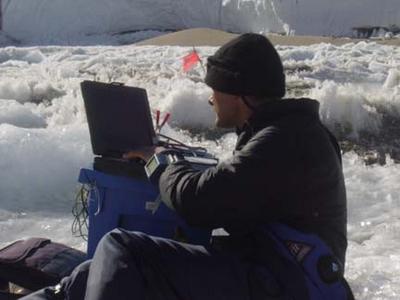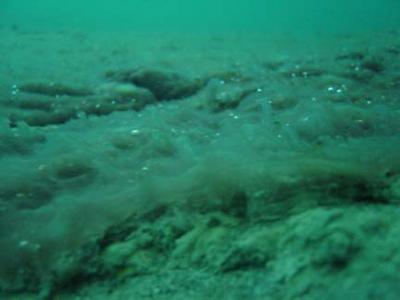22 November, 2004
Double Dive Day!
Temperature: 15*F
Location: Lake Hoare
Every time a diver is in the water, three people are involved: the diver, the
safety diver, and the emergency assistant. The safety diver is always
completely suited up and ready to grab the back up dive gear and go through the
hole to help the diver. The emergency assistant stays topside and radios for
help if needed and assists the divers when they return to the surface. Ian and
I are always the diver or back up diver.
It is quite a process to dive in Antarctica. It takes considerable effort to
make a single dive, let alone two dives. For the last couple days, Ian has
done two dives a day. Today, we both dove twice for a total of four dives.
We both collected more core samples, I took light intensity measurements, and
Ian took another oxygen levels profile through the mat. We had a very
successful day and collected a tremendous amount of data.
In order to measure light levels, I took a light sensor on my dive. The light
sensor was connected to a computer on the surface which would record the
intensity level. I first made measurements in a straight line moving away from
the hole just below the ice; the water depth was 14 feet. I communicated to
Ian when I was in position, and he signaled the computer to record the
intensity level at that location. I swam 10 meters further away from the hole
between each measurement. We did this for six measurements. After the last
measurement, I then positioned myself to take a water column profile of light
intensity. This involved lowering myself towards the bottom at 10 foot
intervals. It's a bit tricky to maintain perfect buoyancy within the water
column. I had to hit 24, 34, and 44 feet exactly and hold the position long
enough for the recording to be taken. After a successful profile, I returned
to the hole. I passed off the light sensor and was given my underwater camera.
I spent the rest of my dive photographing the mats.
My second dive, I collected two more core samples. Although this went smoother
than yesterday, the second sample still proved to be problematic. I
successfully pounded the core tube into the sediment without breaking it. I
placed the stopper on the top and started to pull the core tube out of the
hole. The sample was coming out beautifully. Then, as I pulled the end out of
the hole, I saw a large rock jammed up inside the tube that had broken the
bottom of the tube. I couldn't put the stopper on because the rock was in the
way. I had trouble getting the rock out of the tube. While I struggled with
the rock, the sample quickly dribbled out of the tube through a small gap
between the rock and the tube edge. I lost most of the sample. I will try
again tomorrow!

1) Ian checks the light sensor program on the computer before my dive.

2. The light sensor underwater. The black on the bottom is my hand.

3. The matt on the bottom. The small bubbles are oxygen being released by the matt.

4. Looking up through the water as I ascend, I can see Ian.
Contact the TEA in the field at
.
If you cannot connect through your browser, copy the
TEA's e-mail address in the "To:" line of
your favorite e-mail package.
|
